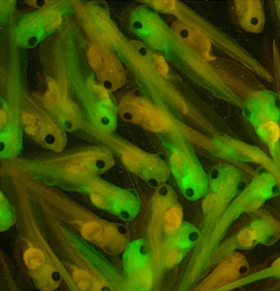
Email caroline.beck@otago.ac.nz
Tel +64 3 479 4109
Teaching
- CELS 191 Cell and Molecular Biology
- GENE 223 Developmental and Applied Genetics
- GENE 314 Developmental Genetics
- GENE 360 Extension Topics and Research Skills
- ZOOL 221 Animal Designs for Living
Research interests
 As a developmental biologist, I am interested in how a single cell, the fertilised egg, progressively acquires the form and function of its parents over time by complex gene regulation. My lab is especially interested in the development of organs such as the vertebrate limb and eye and in the ability of some vertebrates to regenerate these organs. We use the South African Clawed frog Xenopus laevis as a model organism to ask questions about how complex structures are built and rebuilt during embryogenesis and regeneration following injury. Currently we are focussed on determining the origin and role of the skin microbiome in tadpole tail regeneration, and developing tadpole models of infant-onset genetic epilepsy using CRISPR/cas9 editing.
As a developmental biologist, I am interested in how a single cell, the fertilised egg, progressively acquires the form and function of its parents over time by complex gene regulation. My lab is especially interested in the development of organs such as the vertebrate limb and eye and in the ability of some vertebrates to regenerate these organs. We use the South African Clawed frog Xenopus laevis as a model organism to ask questions about how complex structures are built and rebuilt during embryogenesis and regeneration following injury. Currently we are focussed on determining the origin and role of the skin microbiome in tadpole tail regeneration, and developing tadpole models of infant-onset genetic epilepsy using CRISPR/cas9 editing.
For more information about my research please see the Beck lab website.
Current postgraduate students
- Alastair Matheson-Grant (MSc Genetics) Functional analysis of genes associated with secondary neural tube development in Xenopus.
- Jack O'Neill (MSc Genetics) Investigating a de novo variant of EEF1A2 which leads to Developmental and Epileptic Encephalopathy 33 (DEE33) using Xenopus laevis.
Current and potential future projects
- Investigating spontaneous neural tube assembly as a new regenerative strategy for spinal cord regeneration
- Developing pre-clinical models of genetic epilepsy
- Linking the microbiome to regenerative ability
Recent research students
- Sulagna Banerjee (PhD Genetics 2023) A Xenopus laevis tadpole model of epilepsy to test alternative therapeutic targets. (with Dr Paul Szyszka)
- Cabriana Earl (BSc Hons Genetics 2022) Evaluating two novel variants as potential causes of epileptic seizures.
- Campbell Nicholas (BSc Hons Genetics 2022) Investigating the role of TLR2 in Xenopus laevis tadpole tail regeneration.
- Campbell Gilbert (MSc Genetics 2021) The microbiome, immune system and regeneration (with Xochitl Morgan, Microbiology)
- Prashath Karunaraj (PhD Genetics 2021) How noggin-like proteins have evolved and how their functions have changed (with Peter Dearden, Biochemistry)
- Fernando Miguez (PGDipSci Genetics 2020) Identifying the control mechanisms of secondary neurulation in Xenopus laevis
- Matt Reily-Bell (MSc Genetics 2019) Understanding the molecular consequences of RECQL4 disruption in skeletal development (with Louise Bicknell, Pathology)
- Thomas Devine (BSc Hons Microbiology 2018) The microbiome and regeneration (with Xochitl Morgan, Microbiology)
- Thomas Bishop (PhD Genetics 2018) The molecular mechanism of Xenopus regeneration and its activation in mammals.
- Morgan Jones (MSc Genetics) Global demethylation of blastema stem cells during zebrafish tail regeneration reveals new prospects for epigenetic study in regeneration (with Tim Hore, Anatomy)
- Matt Reily-Bell (BSc Hons Genetics 2017) Crispr/cas9 disruption of cdt1 in Xenopus
- Jessica Mckenzie (BSc Hons Genetics 2016) Investigating the evolution of Noggin-like genes and their relationship with axis patterning pathways.
- Jack Foster (PGDipSci Genetics 2015) Role of calpain 8 in limb development and regeneration
- Paulomi Mehta (PGDipSci Genetics 2015) Genetic regulation of proximodistal limb patterning by Fgfs.
- Elisha Wang (PhD Genetics 2014): Roles and expression of Fgf/RTK signaling modulators, Sproutys and Sulfs, in Xenopus limb development and regeneration.
- Samuel Keenan (MSc Genetics 2014) The influence of gremlin-induced BMP inhibition and subsequent associated genetic interactions in Xenopus laevis limb development.
- Olivia Tidswell (BSc Hons Genetics 2014) Knowing your noggin from your trunk: how did the arthropod noggin-like proteins evolve? (With Liz Duncan and Peter Dearden)
- Jessica Bromell (BSc Hons Genetics 2014) The roles of retinoic acid response element-adjacent genes in Xenopus laevis development
- John McNally (MSc Genetics 2013) The role of Retinoic acid as a Morphogenic agent in Xenopus laevis Early Axis Formation and Limb Development
- Jeremy Lynn (PGDipSci Genetics 2013) Characterization of Gremlin induced BMP inhibition during limb development
- Amy Taylor (PhD Genetics 2013): The Role of Epigenetics in Amphibian Regeneration
- Mythrayee Sundaresan (PGDipSci Anat 2012) The role of lgals9c-b and Xgalectin-IIa in the formation of pre-cartilage condensations during Xenopus laevis limb development
- Sam Capon (MSc Genetics 2011) Characterising Cfm2, a novel gene involved in vertebrate development.
- Elisha Wang (MSc Genetics 2011) Revised function of the BMP inhibitor Gremlin in Xenopus limb development and its potential in hindlimb regeneration.
Publications
Chapman, P. A., Hudson, D., Morgan, X. C., & Beck, C. W. (2024). The role of family and environment in determining the skin bacterial communities of captive aquatic frogs, Xenopus laevis. FEMS Microbiology Ecology, fiae131. Advance online publication. doi: 10.1093/femsec/fiae131 Journal - Research Article
Banerjee, S., Szyszka, P., & Beck, C. W. (2024). Knockdown of NeuroD2 leads to seizure-like behaviour, brain neuronal hyperactivity and a leaky blood-brain barrier in a Xenopus laevis tadpole model of DEE75. Genetics. Advance online publication. doi: 10.1093/genetics/iyae085 Journal - Research Article
Murillo, J., Campbell-Thompson, E., Bishop, T. F., Beck, C. W., & Spencer, H. G. (2023). Report of bilateral gynandromorphy in a Green Honeycreeper (Chlorophanes spiza) from Colombia. Journal of Field Ornithology, 94(4), 12. doi: 10.5751/JFO-00392-940412 Journal - Research Other
Panthi, S., Chapman, P. A., Szyszka, P., & Beck, C. W. (2023). Characterisation and automated quantification of induced seizure-related behaviours in Xenopus laevis tadpoles. Journal of Neurochemistry, 15836. Advance online publication. doi: 10.1111/jnc.15836 Journal - Research Article
Hudson, D. T., Bromell, J. S., Day, R. C., McInnes, T., Ward, J. M., & Beck, C. W. (2022). Gene expression analysis of the Xenopus laevis early limb bud proximodistal axis. Developmental Dynamics, 251, 1880-1896. doi: 10.1002/dvdy.517 Journal - Research Article